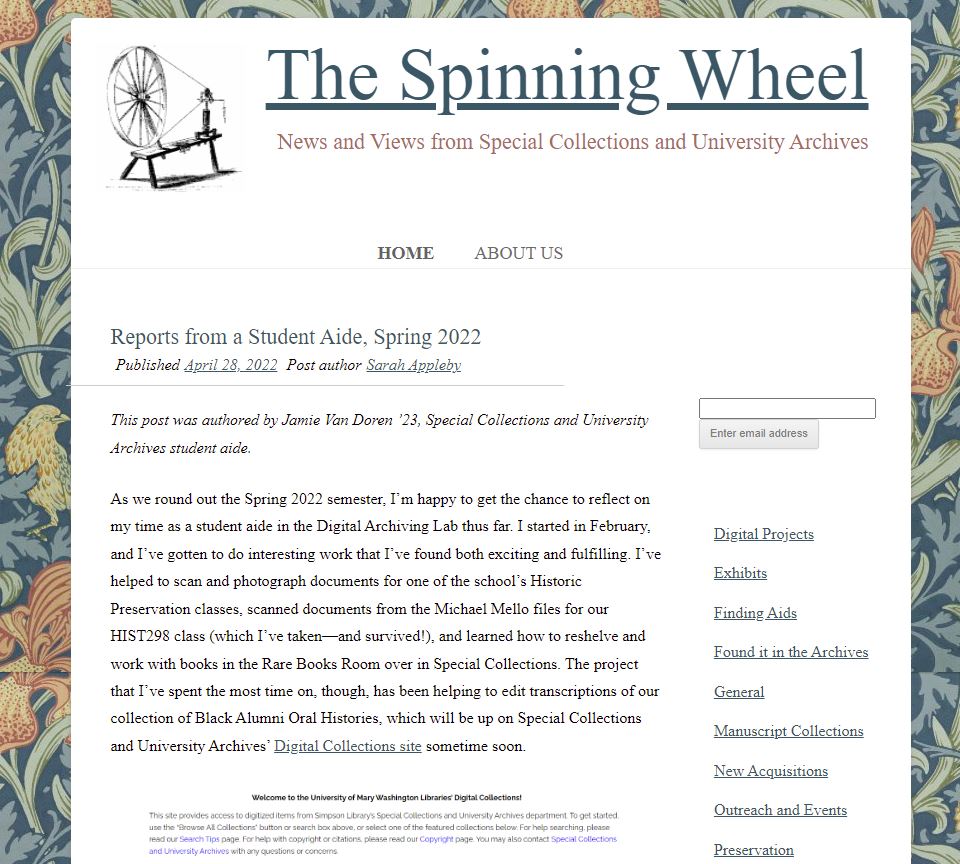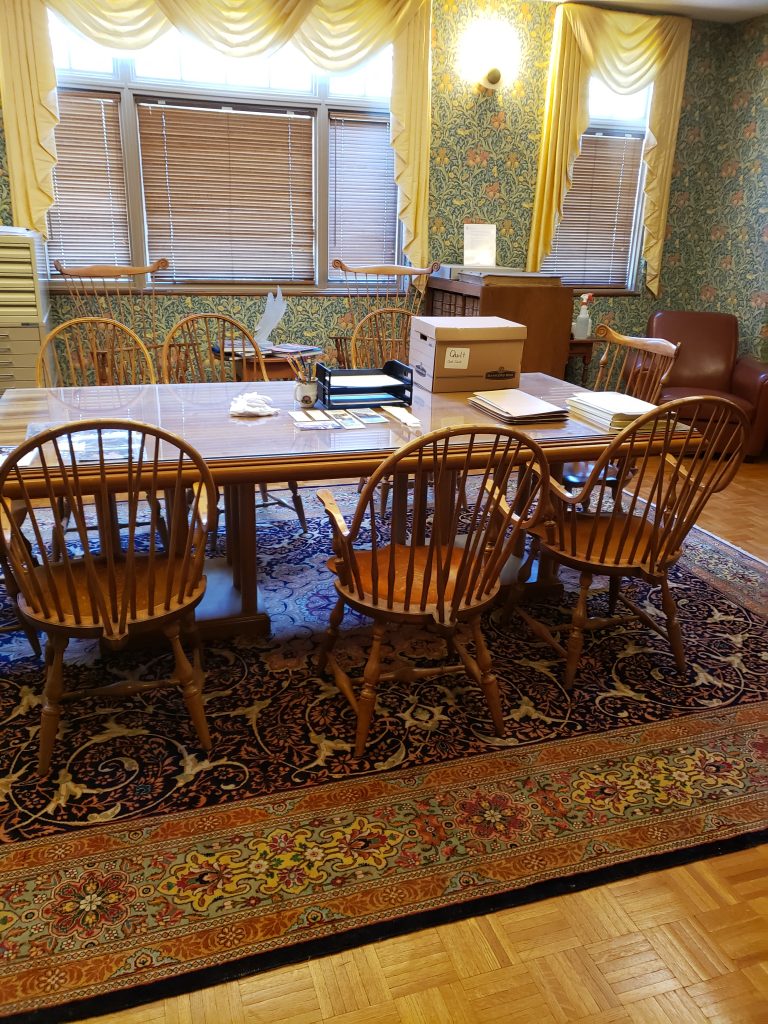Due to proximity and summer hours, I was unable to visit a standalone Special Collections Library, but was fortunate to see the one housed at University of Mary Washington. Rubin & Rubin (2020) state “In a few cases, the term special library can be applied to independent within universities,” (p.199); that is the case here.
Digital Access
Given the size of this library, I’m impressed by the comprehensiveness of their website. The three staff positions are listed, though one is vacant. It also clearly states that visits are made by appointment only. The resources are different than those presented on the main library page, but quite relevant to the potential needs of anyone investigating Special Collections (for example, details on Research and Instruction opportunities within Special Collections, and a link to their blog, pictured below).

I’d be curious to know if the website was this detailed prior to the pandemic, and I could probably find out by looking at their digital archive of the website! As a mere member of the public, I was able to access digitized collections without logging in (there’s a link). Searching the catalog allowed me to see what they have and where it is located in the library, but not access details. There is also a collection of digitized “projects and exhibits” that are entirely online and accessible to the public. It’s nice that they are clearly making an effort to be relevant and available.
The Space
This library is located on the 2nd floor of the main library on the UMW campus. It is tiny. I was able to speak with the Records Coordinator, Sarah (since I had to make an appointment to go visit), and she was super informative. This space felt like I imagine a Special Collections library should–small, cozy, smelled old. There was a cute display out front with some artifacts from the Women’s Suffragist movement. The library has a rare books room, a university archives room, a large table and some chairs. There are a two big file cabinets and a cool original card catalog. That’s about it, except for the Library office!

Any of the collections require an appointment and assistance from the staff unless they are digitized. Other than the elevator being wheelchair accessible, no specific accommodations are listed on the website. The table is an accessible height. This space would allow for small group work with supervision of staff, and Sarah told me that sometimes a small class (maybe 15 students) will come in for a presentation. There isn’t much signage in the library itself, which is ok because you can’t go looking for items on your own anyway. The library staff have appropriate labels for themselves to find materials.
Services and Intellectual Access
The library provides digital archiving services; requests can be submitted online. No programs are evident, but Sarah told me they will occasionally collaborate with teachers. For example, she had recently conducted a lesson on rare books with a small class. The catalog is not accessible in the physical library, but is fully searchable online–since you need an appointment to be there anyway, being able to search the catalog in person isn’t really necessary as there is a librarian at your disposal. If someone really wanted to, they could exit the Special Collections department and use one of the catalog computers in the main library. The library is categorized using Library of Congress designations. All patrons are clearly welcomed–the benefit of the appointment-only system means personalized assistance and accommodation of any needs. According to Rubin & Rubin (2020), “special librarians must regularly communicate their value…using verbal and visual language that reflects the culture of the organization.” Sarah communicated this very well. I think the relevance of the space has been accomplished by the services this Special Collection provides–being the keeper of University Archives and also Records Management (assisting departments and staff in the keeping and disposing of grades, personnel files, payroll, etc.) makes them vital to the organization because this is required by the state.
People
Since visits are by appointment only, I was alone with the librarian, who was white. Sarah is the Records Coordinator. There is also an Interim Head of Special Collections and University Archives, and vacant Digital Resources Librarian position. Sarah told me that during the regular school year, they also have student aides. The physical space is primarily used for individuals examining pieces from the collection with staff assistance/supervision. I’d say that most of the clientele are UMW staff and students, particularly since the library also handles Records Management for the university.
Collections
The library houses rare books, journals, and has a collection of WWI posters. They also collect University Archives (dissertations, old newspapers, yearbooks, etc.), though most of these are now being digitized due to convenience and a lack of space. There is also a vast digital collection of a variety of artifacts, including posters, photos, videos, publications, and much more. I asked how new physical items get added to the collection, and was told that often it’s when books are weeded from the main library and then reviewed for inclusion in the rare books collection. Sarah said that sometimes it can be challenging dealing with members of the public who want to donate to the collection–it’s a matter of deciphering what is valuable historical record versus what is just old (like a grandmother’s letters).

Final Notes
In general, I’d say this library felt exactly how I imagined a small university Special Collection would feel–but I’m very impressed by their digital presence. When the opportunity arises, I’d like to be able to visit a larger facility to see the difference between a standalone collection and one of this type.
Rubin, R. E. & Rubin, R. G. (2020). Foundations of library and information science (5th ed.). ALA Neal-Schuman.
I really like their website – it seems very user friendly. The small class about rare book sounds interesting. Do they have some rare books in their collections?
The collection includes a large number of rare books, yep!
You know, even though that collection is small, that time you spent one-on-one was probably very valuable. That might form a bond that could help you down the road. Did she have any other duties other than the special collection? I was curious in some small special collection libraries just what you are dealing with sometimes…is there enough to keep you busy?
The special collections library also handles University Archives, Records management, and Digital Archiving, so yes, I think she has plenty to keep her busy!
I was surprised to hear that the special collections librarian processes administrative records like grades, personnel and payroll for the whole school. How do they determine what needs to be saved or do they just maintain a digital record somewhere? It great that a lot of their special collections are digital and accessible by anyone. Being a digital resources librarian sounds really interesting, I’d love to know more about it!
So it seems like they just help with that stuff–not necessarily manage it entirely. But I could be wrong.
What a great resource at that school! When special collections are donated I wonder if the facility then creates new classes or mostly incorporates collections. I’d love to take an online class on women’s suffrage and see the special collect pieces. Thanks for such great information!
The student worker roles at this special library sound very interesting, especially as it also contains university-specific archives. I imagine that is interesting for any students studying history, or with an interest in preservation work, to get some hands-on experience. I also think it’s important to get a student perspective on archives, as one day these students may be in the university archives themselves, and should be part of documenting their own history. My guess is that they do work-study for these jobs, so these students can also make some money?
What a neat little library. These small special collections libraries are cool to visit but I don’t think I could work in one.